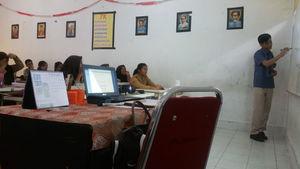Selamat datang di SMP Lab School UNTAD Palu!
- Rogel John Naval

- Jan 28, 2018
- 3 min read
On a bright Tuesday morning, just two days after I arrived in Palu City, we were scheduled to visit the school where we will be deployed for our practice teaching, that is, the SMP Lab School UNTAD Palu. This school is a laboratory school of the Tadulako University under the Faculty of Teacher Training and Education (FKIP).

Upon entering the campus, the school Principal, Pak Nyoman Muliasa, S.Pd., M.Pd., welcomed us. All the SeaTeachers (including myself), were assigned to the Lower Secondary School. He led us to the Ruang Guru (Teacher's Room) where all the teachers were waiting for us. One by one, the teachers introduced themselves with their name, how we can call them, what subject they teach. What got my attention was when one of the teachers, Sir Mahyudin, introduced himself, he said that he taught robotics -- a subject that is specially offered in the school. This was the first time I encountered a school teaching robotics as a subject. Most of the time, in the Philippines, it is only a form of an extra-curricular activity. We felt how warm they received us because they assisted us with everything we needed like serving us traditional food, teaching us Indonesian culture, to name a few.



After the event, our companions already gave us our schedule of classes. The first thing I noticed was every period only has 40 minutes, but each subject would have at least two periods. Meaning, every teacher would teach one class for at least 1 hour and 20 minutes, which for me is A LOT! Attached below is a photo of my weekly schedule. I meet my four sections twice a week -- one period is one hour and 20 minutes long while another period is 2 hours long. It was a big challenge for me on how to maximize the time. It was a difficult adjustment for me since I was used to teach for only one hour for every class in the Philippines during my previous practice teaching shift.

What got my attention again was how many subjects there are per day. Everyday, there are only three subjects. Compared to the Philippines, there are 7 to 8 subjects per day. I think this is good for the students because they are not heavily bombarded with academic load and they get enough time to rest at home and enjoy their time as children. However, I am surprised by how little the time allotted per subject is per week. For mathematics in 7th Grade, only 200 minutes, or 3 hours and 20 minutes is allotted for the subject.

A lot of learning resources are available in the school. Generally speaking, each classroom has air condition units. There are also projectors (they call it inFocus) available at the Ruang Guru. A very big speaker and sound system is used whenever there are programs is also used. There is a basketball court, a volleyball court, and a futsal court for students to use. Moreover, the school has wide enough space for other activities for a large crowd.
In the lab school, my mentor, Sir Affandi Amat Salim, S.Pd., gave me the topics I will be teaching. He said I will be teaching topics under Social Arithmetic like Financial Profit, Financial Loss, Break-even, and Simple Interest. I was not expecting to teach business mathematics topics at all. I was expecting more of either algebra, geometry, or statistics. Nonetheless, I accepted the topics he asked me to deliver. I got curious why he asked me to teach those topics because in the Philippines, our mathematics curriculum discusses that during the 4th grade. I asked him about it and he said that the mathematics curriculum of Indonesia follows a spiral approach (following Jerome Bruner's Constructivism theory) where topics are brought up every year but with a higher difficulty as students progress. Also, in their curriculum, there are competencies for the three domains (cognitive, affective, and psychomotor) such as respecting the teachings of their religion, recognizing social arithmetic phenomena, and having values on persevering to solve problems, and more. These are all indicated on the lesson plan.
Upon visiting the lab school on our first day, I got a brief overview of the educational system of Indonesia. Definitely, there are some similarities and differences as to how the educational system is delivered to the students by the school. But certainly, these are some things to learn from.






Comments